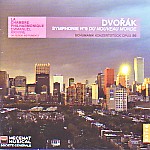Everything about this performance of Dvorák’s Ninth is bad: the concept, the conducting, and the playing. First, the concept: the very idea of Dvorák on “original instruments” is stupid. The “New World” Symphony was premiered by the (now) New York Philharmonic at Carnegie Hall in 1893. There is no evidence that the sound of that orchestra was notably different from what we expect in a modern orchestra today, whether in terms of string vibrato, number of players, or any other substantive factor. Certainly we know that it was a full-size ensemble, not the half-size (or less) string forces that Emmanuel Krivine uses here. Take the notorious vibrato issue. Writing in 1877, the prestigious Boston-based Dwight’s Journal of Music (Vol. 35) noted: “Solo players on the violin have not been permitted its [vibrato’s] exclusive use, but all the members of the stringed family freely employ it.”
Turning to the symphony itself, let’s take a concrete example–the big orchestral outburst at the climax of the Largo. Chamber-sized forces play havoc with balances and dynamics; the trumpets are too loud, the trombones too soft. The violins sound positively hideous, partly the result of the fact that they remain muted. This is a mistake that is corrected in the Breitkopf Urtext edition of the score, which you would think Krivine would be using given his concern for “authenticity”. With normal-sized forces the effect can be interesting. For example, Norman del Mar (writing before the Urtext edition was published) argues in favor of retaining the mutes, even though it has generally been customary to play without them. Either way, a pint-sized group of fortissimo muted violins playing against the full complement of woodwinds, brass, and timpani is an aural atrocity that no conductor should be willing to tolerate. Krivine represents a triumph of pedantry over musicality. Then there’s the main theme, too quick and strikingly inexpressive when it returns.
This brings up the question of Krivine’s interpretation, such as it is. It’s basically fast and emotionally shallow, except where it’s not, in which case it’s choppy and random. What this means is that in slower sections, such as the first movement’s introduction or the opening chords of the Largo, he indulges in plenty of “romantic” flexibility–odd pauses, inconsistencies of pulse from note to note–that destroy any sense of rhythm and make the main tempo of the respective movement seem anomalous. And then there are “authentic” touches such as that single, theoretically stylish violin portamento in the first movement’s second subject, a moment so self-conscious and obviously external to the basic string phrasing and timbre going on everywhere else that it sounds like an ensemble error.
Nor does the use of chamber forces provide a greater degree of textural transparency. The canonic entries of the woodwinds in the scherzo’s main section aren’t notably more audible than we normally hear; and as you might expect from such reduced string forces, bass lines in this movement and elsewhere might as well be nonexistent. In short, what we have here is a sterile, tedious lecture-demonstration of a completely speculative and erroneous theoretical construct, rather than a thoughtful, expressively vital, and captivating performance of Dvorák’s “New World” Symphony. The Schumann is hardly better: the horns sound alternately blaring and watery, and in softer passages their intonation seems a touch suspect. Here is yet another example of “concept” triumphing over musical common sense. But then, as Robert Heinlein once observed, “Sense is never common.” [11/12/2008]
































